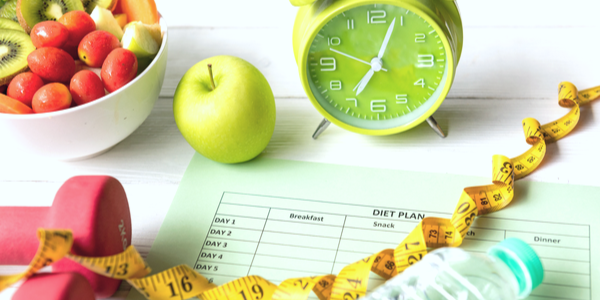
Frustrated with the scale, you research "how to lose 10 pounds in 3 days" and "fast weight loss tips". Fad diets likely flood the search engine, though nutrition experts encourage steering clear from such diets claiming to lose weight so fast.
But losing 10 pounds quickly, yet sustainably, is not out of the question! Besides, losing and maintaining a healthy weight can lower heart disease risk, improve blood sugars, amongst countless other benefits.
So, how long does it take to lose 10 pounds? Find out this timeline and how to lose the weight once and for all!
How Long Does It Take to Lose 10 Pounds?
Although a straightforward answer to the question would be ideal, many factors should be considered when it comes to weight loss.
First off, weight can fluctuate daily based on diet, bathroom patterns, and hydration status that ebb and flow water weight. For actual fat loss, losing 10 pounds varies based on a number of factors, including body composition, gender, and age.
Simply put, losing one pound of fat requires a 3,500 calorie deficit. Most nutrition experts encourage losing no more than one to two pounds in a week unless guided by a healthcare professional.
If following and desiring that weight loss pace, losing 10 pounds takes an average of two months give or take:
• 1 to 2 pounds per week X 4 weeks in a month = 4 to 8-pound loss
• 4 to 8 pounds X 2 months = 8 to 16 pounds
However, people with more weight to lose tend to drop weight faster. For instance, someone trying to lose 50 pounds will likely lose 10 pounds faster than someone with 15 pounds to lose.
Long-Term Weight Loss Advice for Success
Whether wanting to lose 10 pounds in a week, month, whathaveyou, sustainable weight loss is more like a marathon rather than a sprint.
From tracking food intake to eating based on hunger, use this weight loss advice for long-term success!
1. Start Tracking Food
Especially when embarking on a weight loss journey, starting a food journal can be highly beneficial. A study has shown people who kept a food log lost twice as much weight as people who did not! Tracking food intake helps increase awareness of dietary patterns, including frequency and volume of food intake.
When logging, be as specific and detailed as possible. Include condiments, beverages, and small candies as well, as these can easily add up over an entire week.
All in all, calorie counting is not always necessary for sustainable weight loss. However, tracking is helpful when first starting out to get a better grasp of individual baselines.
2. Choose Colorful Foods
Choosing foods vibrant in color, rather than processed and purchased from a box, is a simple approach to obtain critical nutrients.
Comprising half the plate with color helps ensure adequate fiber, vitamins, and minerals while naturally keeping calories in check.
3. Slow Down at Mealtimes
Did you know it takes about 20 minutes for the brain to recognize satiation and the stomach to feel full? That being said, eating quickly can compromise satiety cues and increase the risk of overeating.
So rather than eating too fast, slow down at mealtimes. Do so by chewing 10 times before swallowing, putting the fork down between bites, and savoring the flavor of foods.
Also, consider food and snack items that need a little extra work beyond opening a chip bag. Peeling oranges and deshelling seeds are ideas to slow down the eating process.
4. Eat Based On Hunger (Not Cravings)
Unlike cravings, which are often based on psychological desire, hunger is a physical need for food. Hunger is often not exclusive to one food and people likely feel satisfied after eating. If left unmanaged, hunger results in a growling stomach, headache, and loss of energy.
Mindful eating is a growing weight loss tip for portion control. Instead of focusing on the quantity of food, mindfulness promotes abiding by the body's cues of hunger and satiety.
To practice mindful eating, start noticing whether or not the body is actually hungry or experiencing a craving. Eat nutrient-dense foods that nourish the body and avoid any distractions during mealtime.
For instance, skip TV snacking and meals and welcome the dinner table with loved ones!
5. Use Smaller Plates for Meals
Finishing everything on the plate reduces food waste, but it can result in overeating if meals are served on larger plates. So to keep portions in check, use smaller plates for mealtimes.
Begin looking at the size of your current plate. If larger than a frisbee, it is probably too large and properly-sized portions look small. Look for a plate about 8 inches or less in diameter to retrain your eyes to the right portion size.
Using smaller spoons to eat desserts can also help you savor the flavor of a smaller portion in a smaller bowl. The decadent flavor is likely to last longer, too!
6. Keep Hydrated with Water
Thirst is often mistaken for hunger, leading hands into the pantry instead of onto a water glass. Drinking water is critical for digestion, along with increasing satiety to reduce the risk of overeating at meals.
Healthy adults are encouraged to drink at least eight, 8-ounce glasses of water per day. Limit fruit juice, energy drinks, and other beverages that are laden in sugar as well.
7. Defeat the Snack Attack
Snacks tend to be the first to go when dieting, as ridding them is a simple way to cut out calories. However, this is not necessary! (But this does not grant the permission to continue heading to the vending machine…)
Snacks should mostly be rich in protein due to their high satiety factor. Pairing with fiber and healthy fat can further help the body feel full. Easy and healthy snack ideas include nuts, an apple with peanut butter, and yogurt and berries.
To ease a busy morning, pack healthy snacks for the next day. Take them to work or while running errands to curb hunger when it starts to surface.
8. Try a Mix of Aerobic & Anaerobic Activity
When trying to lose 10 pounds in a month or another specific timeline, dieters tend to amp up the cardio or aerobic activity. Cardio burns sufficient calories and is advocated to result in quicker weight loss.
The American Heart Association (AHA) encourages a minimum of 150 minutes of aerobic activity weekly. Or, at least 30 minutes a day most days of the week. Cardio exercises include running, brisk walking, swimming, dancing, cycling, or any activity that elevates the heart rate.
While cardio accelerates weight loss, strength training leads to sustainable weight loss by increasing and preserving muscle mass. Generally speaking, greater muscle mass is able to burn calories more efficiently and quickly, even when the body is at rest.
Include weight and strength training at least two or three times a week. Focus on the major muscle groups, including the back, chest, arms, and legs.
If short on time, consider tackling a high-intensity interval workout that can be completed in under 30 minutes. Not only do HIIT and Tabata-style workouts elevate heart rate quickly but can burn calories well after completion.
9. Make Physical Activity Enjoyable
Exercise is an integral component of successful weight loss, though is often attributed as a chore. But workouts can be much more than hours spent at a gym and should be enjoyable!
Fun ways to get active include taking a Zumba class with friends or playing a friendly game of kickball with family. The importance of getting active is not exactly how you do it, but that you do and enjoy it!
Simply make it an effort to increase daily movement by taking the steps, biking to work, or walking on a lunch break. Even just 10 minutes at a time can make a big impact.
10. Manage Ongoing Stress
First off, the body releases the stress hormone cortisol when stressed. Cortisol can put the body in starvation mode, which encourages the body to store fuel and belly fat. Emotion-based eating can also pack on unwanted calories and fuel the risk of a binge.
Combat against emotional eating by managing stress or other influences that are fueling emotions. Stress-relieving techniques may include taking a walk, lifting weights, practicing yoga, or talking with a close friend.
11. Ensure Adequate Sleep Nightly
While most people associate diet and exercise with health, the importance of sleep should not be discounted. There is a strong link between lack of sleep and weight gain, as sleep deprivation can heighten cravings toward comfort foods. Plummeted energy can be a consequence, too.
The National Sleep Foundation recommends adults 7 to 9 hours of sleep each night. Doing so can help reach weight loss goals, amongst other physical and mental benefits.
12. Grow & Maintain a Strong Support System
Research shows strong support systems lead to better weight management outcomes. This includes individual and community levels.
Find support in family members, friends, coworkers, and neighbors. Online and community support groups can likewise be beneficial.
The Bottom Line On Losing 10 Pounds
How fast one loses 10 pounds depends on so many factors like gender, age, hormones, lifestyle choices, and beyond. Some factors, such as gender and age, are fixed but, fortunately, others are within personal control. These include dietary patterns, exercise regimens, and sleeping habits.
A successful 10-pound weight loss, and maintaining that weight loss, deserves lasting attention. Meaning, once that goal weight is met, to not revert to old ways like daily sedentary habits and nightly ice cream binges.
Overall, aim to put your best foot forward while focusing on health at large. Absolutely can weight loss lead to a healthier, happier you but finding a balance in doing so is key.







